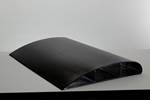Composite combat drone inlet duct proves novel fabrication approach
The 30-foot overbraided Frankenstein demonstrator was designed by NIAR, A&P and Fiber Dynamics to explore more flexible manufacturing of complex composite structures.
Wichita State University’s (WSU) National Institute for Aviation Research (NIAR) recently partnered with A&P Technology (Cincinnati, Ohio, U.S.) and Fiber Dynamics (Wichita, Kan., U.S.) to build a composite inlet duct for a combat drone aircraft using a novel overbraiding technology.
Researchers with NIAR’s Advanced Technologies Lab for Aerospace Systems (ATLAS) designed the inlet duct as a part of a manufacturing demonstrator called Frankenstein (FS-19), which is a 30-foot unmanned combat aircraft. The project, part of the Air Force Research Laboratory’s (AFRL, Wright-Patterson Air Force Base, Ohio, U.S.) Manufacturing for Affordable Sustainable Composites (MASC) program, is a proof-of-concept for low-cost, high-rate production worthiness.
“This manufacturing demonstrator is intended to generate a cost model based on manufacturing data that includes various materials and manufacturing and assembly methods, allowing manufacturers to use the information for on-demand flexible manufacturing and assembly of composite structures based on volume, cost, weight and mission requirements,” says Waruna Seneviratne, ATLAS director.
The complex curvature of the inlet duct demanded a novel approach to manufacture. Placement of tows using automated tape laying (ATL) is limited due to the radius of curvature, and hand placement of prepreg would result in excessive cutting and splicing. The overbraiding technology was developed by A&P Technology and was identified by AFRL as a key process for high-rate production of aircraft parts. The technology is capable of producing multiple duct preforms per shift.
The demonstrator inlet duct is approximately 8 inches long with perimeters ranging from 56.5-96.6 inches. Fiber Dynamics created a melt-out mandrel using its Thermocore Lost Core Tooling System. A&P Technology used this system to overbraided five layers of triaxial braid at a constant thickness of 0.10 inch thick, resulting in angle changes along the length of the part ranging from 55-74°. There were no cuts or splices created during the overbraiding process, and the precise control of fiber angle provides consistently high part-to-part repeatability.
A&P Technology and Fiber Dynamics are working through the MASC research program to develop a path to certification of overbraided structures. NIAR and A&P previously partnered to generate FAA-approved design allowables for 2×2 biaxial braid for resin transfer molding (RTM) of control surfaces of a Raytheon Premier I Part 23 business jet. By creating a certification method for a more automated layup process like overbraiding, MASC continues its work to create affordable and sustainable methods of manufacture.
The proposed path to certification includes establishing a one-point certification method that fully qualifies a nominal angle with laminate analysis predictions for angle changes, similar to advanced fiber placement (AFP) techniques and Laminate Plate Theory rotations of flat fabrics. Once qualified, predictions will be validated through simplified bridge testing of predicted properties at various angles.
Related Content
-
Infinite Composites: Type V tanks for space, hydrogen, automotive and more
After a decade of proving its linerless, weight-saving composite tanks with NASA and more than 30 aerospace companies, this CryoSphere pioneer is scaling for growth in commercial space and sustainable transportation on Earth.
-
Microwave heating for more sustainable carbon fiber
Skeptics say it won’t work — Osaka-based Microwave Chemical Co. says it already has — and continues to advance its simulation-based technology to slash energy use and emissions in manufacturing.
-
Recycling end-of-life composite parts: New methods, markets
From infrastructure solutions to consumer products, Polish recycler Anmet and Netherlands-based researchers are developing new methods for repurposing wind turbine blades and other composite parts.

















